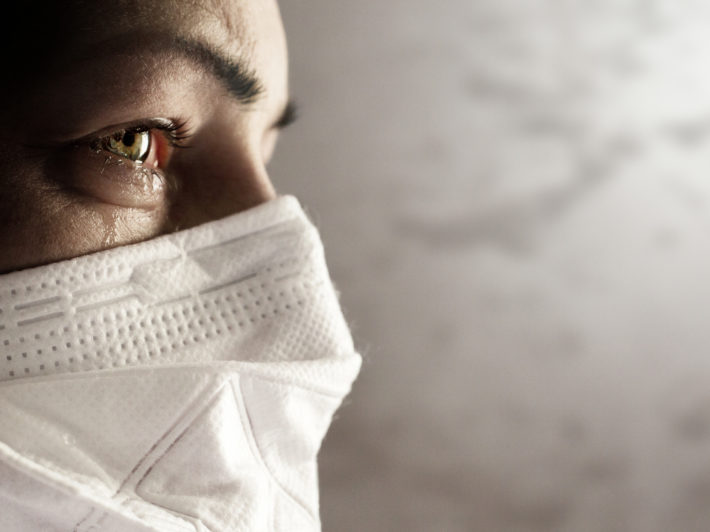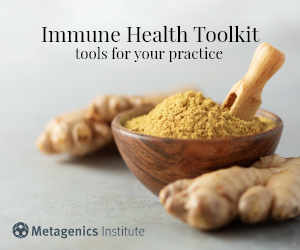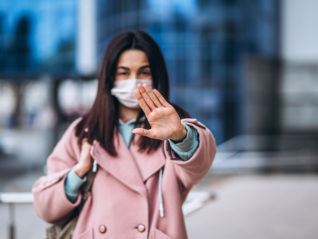
by Lewis Chang, PhD
What is cytokine storm?
Cytokines are a diverse group of polypeptides secreted by cells that have numerous physiological functions, including regulation of inflammatory and immune responses. The rapid response of our highly complex immune system against pathogens or cellular damage is vital for maintaining homeostasis and health.
Cytokine storm refers to a situation in which the protective immune response goes out of control, leading to unregulated release of excessive amounts of cytokines that spill into systemic circulation. This severe immune overreaction can result in systemic sepsis, widespread tissue damage, and multiorgan dysfunction or failure.1
Cytokine storm can be a consequence of severe viral, bacterial, or fungal infections of the lung, gastrointestinal tract, urinary tract, or other sites.1
What is the impact of cytokine storm in COVID-19?
In response to rapid replication of the novel coronavirus (SARS-CoV-2), a large number of leukocytes and macrophages infiltrate lung tissues defending the host. The release of cytokines from these cells activate more immune cells in a positive feedback loop, causing cytokine storm that contributes to acute lung injury (ALJ) that can develop into acute respiratory distress syndrome (ARDS) and diminished survival.2
Several studies have demonstrated that cytokine storm correlates to severity and unfavorable clinical outcomes of COVID-19 infection. For example:
- When comparing the clinical features between ICU and non-ICU patients of COVID-19, ICU patients had higher plasma levels of cytokines (IL-2, IL-7, IL-10, GSCF, IP-10, MCP-1, MIP1A, and TNFα) than non-ICU patients.3
- Multiple studies reported that IL-6 (a cytokine and a marker reflecting the intensity of systemic cytokine responses) was significantly elevated in nonsurvivors compared with survivors of COVID-19 and also in critically ill patients compared with mild patients.4-6
- One study observed significantly higher levels of IL-6, IL-10, and TNFα in COVID-19 patients and the levels of these cytokines decreased during recovery.7
Also, cytokine storm dampened immune function against COVID-19. For example:
- Lymphocytopenia (an abnormally low number of lymphocytes in the blood) was prevalent in COVID-19 patients. The drop in CD8+ T cells and natural killer (NK) cells was particularly significant in severe cases compared with mild cases.5
- High levels of IL-6, IL-10, and TNFα were correlated to significantly reduced numbers of CD4+ and CD8+ T cells in severe patients, and the surviving T cells appeared to be functionally exhausted.7
- Autopsy findings showed that the secondary lymphoid tissues such as spleen and lymph nodes had been damaged in COVID-19 patients.8
- Based on these observations, some suggested that the novel coronavirus may be targeting lymphocytes.9 However, others argued that because ACE2 receptors (the entry point of SARS-CoV-2) are not expressed in lymphocytes, it is cytokine storm that destroyed lymphocytes.8
It has been observed that many severe patients of COVID-19 have key features akin to secondary hemophagocytic lymphohistiocytosis (sHLH), a hyperinflammatory disorder characterized by unremitting fever, cytokine storm, cytopenias, high ferritin levels, high liver enzyme levels, and multiorgan failure.6 As sHLH is commonly triggered by viral infections, some suggested it may be valuable to screen COVID-19 patients for markers/criteria of sHLH to identify the subgroup of patients experiencing cytokine storm for whom immunosuppression could be life-saving.10
Are there effective treatments to target cytokine storm in COVID-19?
Targeting dysregulated immune response and the hyperinflammatory state has been challenging in reality. In a recent publication, a group of immunologists who have had clinical experience in COVID-19 management described some of the key issues:8
- Medications aimed to reduce overactivated immune response may also delay the elimination of SARS-CoV-2 and increase susceptibility to secondary infection.
- Anti-inflammatory medications may not target the right type of cytokines that are important in cytokine storm specific to COVID-19.
- Some anti-inflammatory agents may block productions of cytokines that are important in fighting the virus.
- The window for targeting cytokine storm in COVID-19 may be small; suppressing immune response and inflammation at the wrong time during the disease course could worsen the disease outcome.
SARS-CoV-2 is novel to humans; therefore, existing treatments are not available. More than 300 clinical studies and intervention trials related to COVID-19 are currently under way.11 Interventions that are being investigated, either as standalone, combinations, or adjunctive therapy, include (but are not limited to): antiretrovirals (e.g., lipinavir/ritonavir), antivirals (e.g., remdesivir, umifenovir), interferons (e.g., interferon-α), antihelminthics (e.g., nitazoxanide), corticosteroids, anticytokines (e.g., tocilizumab), immunoglobulins, peroxisome proliferator-activated receptor agonists (e.g., gemfibrozil), antioxidants (e.g., N-acetylcysteine, quercetin), and anti-TNF therapy.
Some of the early clinical experience with existing anti-inflammatory and immunomodulatory agents are briefly described here.
Glucocorticoids
- Systemic glucocorticoids as an adjunctive therapy have been empirically administered to suppress cytokine storm-related complications. Although the findings are not consistent, the benefit seems to outweigh the risk.8
- Some endocrinologists have suggested that any patient with a dry continuous cough and fever should immediately double their daily oral glucocorticoid dose and continue on this regimen until the fever has subsided.12
Chloroquine/hydroxychloroquine (CQ/HCQ)
- CQ/HCQ has recently been shown to reduce the SARS-CoV-2 viral load in vitro.13,14
- Early clinical data have shown inconsistent findings; for example, one single-arm study reported that HCQ was associated with viral load reduction and disappearance in COVID-19 patients,15 but another study found no effect in patient recovery rates.16
- More than 10 clinical trials with CQ/HCQ are currently ongoing; their effects on SARS-CoV-2-triggered cytokine storm remain to be determined.
Tocilizumab
- Tocilizumab is an anti-IL-6 medication that has been used in dampening cytokine storm caused by certain diseases or immunotherapy (such as chimeric antigen receptor T-cell immunotherapy).17,18
- Early clinical observation reported that tocilizumab appeared to be an effective treatment option in COVID-19 patients with a risk of cytokine storms.19
- Multiple clinical trials involving tocilizumab are currently under way.
Conclusion
Currently there are no clinical trial data supporting any prophylactic approach for COVID-19. Potential treatment options are being studied in many clinical trials. Before the vaccine and treatment become reality, the most effective way to avoid SARS-CoV-2 infection and its associated cytokine storm is prevention via good and consistent hygiene (e.g., hand washing and sanitizing frequently) and physical/social distancing.
This update reflects current evidence at time of release. Metagenics Institute will follow the development closely and continue to provide updates according to novel evidence.
Citations
- Tisoncik JR et al. Into the eye of the cytokine storm. Microbiol Mol Biol Rev. 2012;76:16-32.
- Channappanavar R and Perlman S. Pathogenic human coronavirus infections: causes and consequences of cytokine storm and immunopathology. Semin Immunopathol. 2017;39:529-539.
- Huang C et al. Clinical features of patients infected with 2019 novel coronavirus in Wuhan, China. Lancet. 2020;395:497-506.
- Zhou F et al. Clinical course and risk factors for mortality of adult inpatients with COVID-19 in Wuhan, China: a retrospective cohort study. Lancet. 2020;395:1054-1062.
- Wan S et al. Characteristics of lymphocyte subsets and cytokines in peripheral blood of 123 hospitalized patients with 2019 novel coronavirus pneumonia (NCP). medRxiv. 2020:2020.02.10.20021832.
- Ruan Q et al. Clinical predictors of mortality due to COVID-19 based on an analysis of data of 150 patients from Wuhan, China. Intensive Care Med. 2020. [online first].
- Diao B et al. Reduction and Functional Exhaustion of T Cells in Patients with Coronavirus Disease 2019 (COVID-19). medRxiv. 2020:2020.02.18.20024364.
- Zhang W et al. The use of anti-inflammatory drugs in the treatment of people with severe coronavirus disease 2019 (COVID-19): The Perspectives of clinical immunologists from China. Clin Immunol. 2020;214:108393.
- Qin C et al. Dysregulation of immune response in patients with COVID-19 in Wuhan, China. Clin Infect Dis. 2020. [online first].
- Mehta P et al. COVID-19: consider cytokine storm syndromes and immunosuppression. Lancet. 2020;395:1033-1034.
- Sanders JM et al. Pharmacologic treatments for coronavirus disease 2019 (COVID-19): a review. JAMA. 2020 [online first].
- Kaiser UB et al. Our response to COVID-19 as endocrinologists and diabetologists. J Clin Endocrinol Metab. 2020;105. [online first].
- Yao X et al. In vitro antiviral activity and projection of optimized dosing design of hydroxychloroquine for the treatment of Severe Acute Respiratory Syndrome Coronavirus 2 (SARS-CoV-2). Clin Infect Dis. 2020:pii: ciaa237 [Epub ahead of print].
- Wang M et al. Remdesivir and chloroquine effectively inhibit the recently emerged novel coronavirus (2019-nCoV) in vitro. Cell Res. 2020;30:269-271.
- Gautret P et al. Hydroxychloroquine and azithromycin as a treatment of COVID-19: results of an open-label non-randomized clinical trial. Int J Antimicrob Agents. 2020:105949.
- Chen J et al. A pilot study of hydroxychloroquine in treatment of patients with common coronavirus disease-19 (COVID-19). J Zhejiang Univ (Med Sci). 2020;49: [Epub ahead of print].
- Le RQ et al. FDA approval summary: tocilizumab for treatment of chimeric antigen receptor T cell-induced severe or life-threatening cytokine release syndrome. Oncologist. 2018;23:943-947.
- Winkler U et al. Cytokine-release syndrome in patients with B-cell chronic lymphocytic leukemia and high lymphocyte counts after treatment with an anti-CD20 monoclonal antibody (rituximab, IDEC-C2B8). Blood. 1999;94:2217-2224.
- Luo P et al. Tocilizumab treatment in COVID-19: a single center experience. J Med Virol. 2020. [Epub ahead of print].
Lewis Chang, PhD is Scientific Editorial Manager of R&D at Metagenics. Dr. Chang received his PhD in Nutritional Sciences at University of Washington, along with his MS in Nutrition and Public Health from Teachers College, Columbia University and BS in Pharmacy from National Taiwan University. Prior to joining Metagenics, he conducted dissertation research and completed a research assistantship and postdoctoral fellowship at the Fred Hutchinson Cancer Research Center in Seattle, WA. Dr. Chang has authored or co-authored and managed the publication of over 30 peer-reviewed journal articles and numerous scientific abstracts and posters. He has quite a green thumb, enjoys opera, theater and jazz, and loves cooking, collecting art, and learning to play gypsy jazz guitar.






